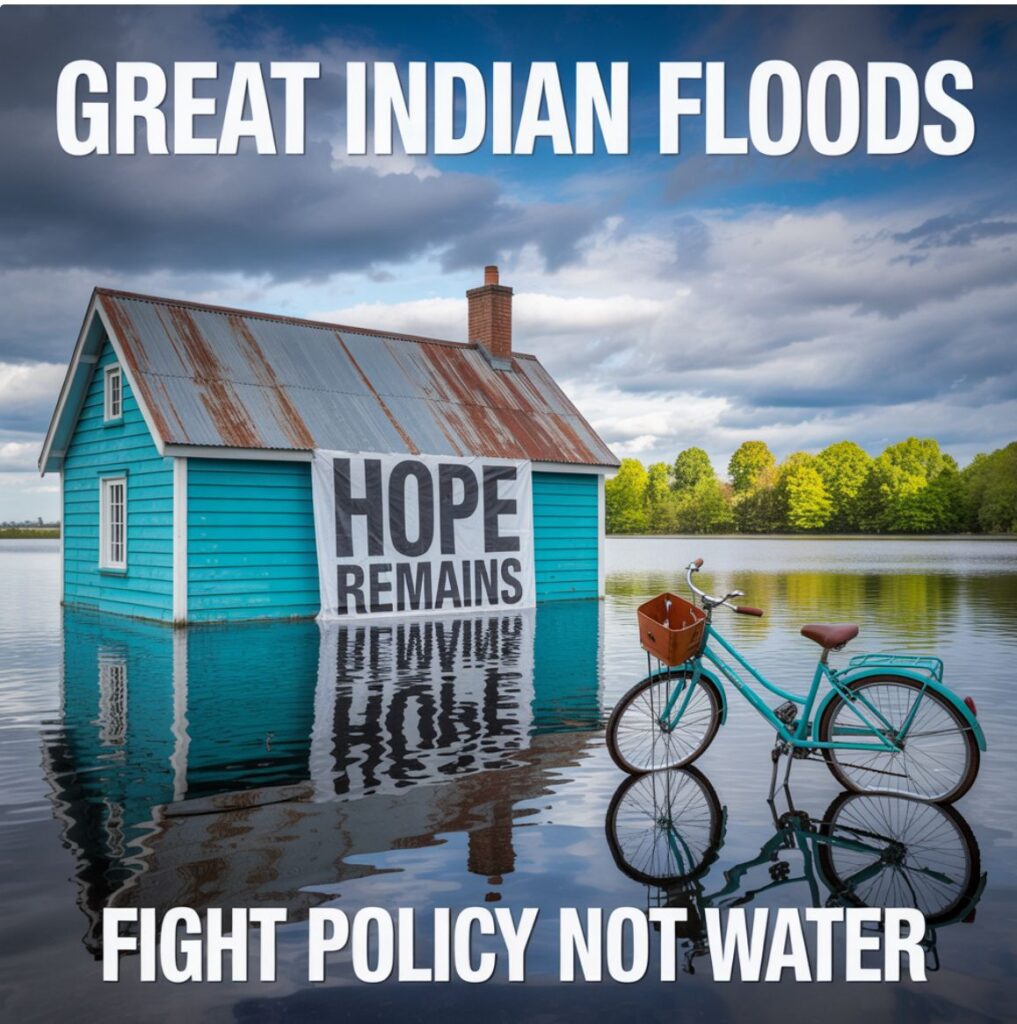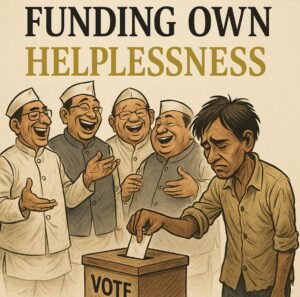Every monsoon, India evaporates nearly ₹58,700 crores while 1.8 Million people disappear

Every monsoon, India performs the same deadly magic trick: we make ₹58,700 crores vanish into thin air while 1.8 million people disappear from their homes. The secret? We’ve mastered spending ₹20 on disaster relief but refuse spending ₹1 on prevention.
The Uncomfortable Truth About Our Flood Management Madness
A doctor who refuses to prescribe medicine for a treatable condition, preferring instead to perform expensive surgery after the patient nearly dies. Absurd? Welcome to India’s flood management philosophy. We systematically starve prevention of funds, then throw money at disasters with the enthusiasm of a gambler doubling down on losing bets. Every monsoon, we watch the same tragic theatre, cities drowning, lives lost, economies shattered while politicians arrive in helicopters promising relief that costs 15 times more than the prevention we refused to fund.
This isn’t incompetence; it’s a calculated choice. We’ve built an entire economy around disaster, where floods aren’t problems to solve but opportunities to exploit. Real estate developers profit from floodplain encroachments worth ₹50,000 crores in Delhi alone. Politicians gain visibility through dramatic rescue operations. Contractors feast on reconstruction projects. The only losers? The 1.8 million Indians displaced annually and the taxpayers funding this madness.
Here’s the number that should haunt every policymaker: Pre-1990s, India spent ₹1 on prevention and saved ₹7 in damages. Today, we spend ₹20 on relief for every ₹1 we refuse to invest in preparedness. We’ve literally inverted the mathematics of common sense.
From Wisdom to Waste: The Great Policy Reversal
Before the 1990s, India understood basic logic. The Sixth Five-Year Plan allocated 25-30% of water budgets to prevention embankments, dams, afforestation. The Damodar Valley Corporation transformed Bengal’s “sorrow” into prosperity through integrated planning. Communities maintained traditional systems like Himalayan kuls and Tamil Nadu’s temple tanks. Annual flood losses? A manageable ₹1,000-2,000 crores.
Then something broke. Post-1990s data reveals our descent into fiscal insanity:
- Relief & Rescue: ₹12,000-20,000 crores annually (65-70% of spending)
- Reconstruction: ₹7,000-12,000 crores annually (25-30% of spending)
- Prevention: ₹800-2,000 crores annually (3-5% of spending)
We now spend more on cleaning up disasters than entire countries spend on infrastructure.
The Anatomy of Avoidable Catastrophes
Kerala 2018: Nature’s bill came to ₹31,000 crores in relief and reconstruction. The prevention cost for wetland protection? ₹3,100 crores,one-tenth the cleanup price. Instead of spending ₹3,100 crores to preserve nature’s flood buffers, we spent ₹31,000 crores mopping up the consequences of ignoring them.
Chennai 2015: The financial capital of South India drowned because we wouldn’t spend ₹400 crores on drainage upgrades. After 60% of wetlands vanished to development, the city paid ₹20,000 crores in flood costs. Prevention-to-relief ratio: 1:50.
Mumbai 2005: India’s financial heartbeat stopped for ₹14,000 crores in damages. The Mithi River drainage upgrade that could have prevented this? ₹500 crores. We chose to pay 28 times more for disaster than prevention.
Himachal 2023: ₹9,042 crores in losses while Glacial Lake Outburst Flood monitoring gets ₹2 crores instead of the required ₹20 crores annually. We’re literally watching disaster approach and refusing to spend on binoculars.
The Politics of Profitable Disasters
Why do we choose disaster over prevention? Follow the incentives:
Electoral Theatre: Helicopter rescues win elections; wetland restoration doesn’t. Compensation cheques generate gratitude; slope stabilization generates nothing visible.
Developer Gold Rush: Mumbai’s Powai Lake lost 40% of its area to luxury towers officially classified as “wasteland.” Delhi’s Yamuna floodplains generate ₹50,000 crores in property value through illegal construction.
Bureaucratic Expedience: Emergency funds flow instantly under “national calamity” provisions. Prevention projects crawl through committee hell for years.
Disaster Capitalism: The ₹12,000-crore Char Dham Highway prioritized over landslide prevention caused ₹8,000 crores in 2023 damages. We build roads that create the landslides we then spend billions repairing.
Urban India: Concrete Graveyards of Wisdom
Our cities house 377 million people in flood-prone concrete graveyards. Bengaluru’s tech hubs lost ₹2,000 crores in 2022 floods because we buried lakes under IT parks. Gurugram the millennium city turns highways into rivers every monsoon, costing ₹500 crores because we forgot that water needs somewhere to go.
The solution? Permeable pavements, lake restoration, green corridors,costing fractions of cleanup bills but politically invisible.
The Himalayan Tipping Point
Climate change is rewriting Himalayan hydrology while we cling to 20th-century thinking. Traditional kuls and naulas once managed water sustainably through community wisdom. Now we spend ₹2,000-4,000 crores annually rebuilding roads after landslides while allocating ₹2 crores for monitoring glacial lakes that threaten millions.
The IPCC (2021) projects 10-20% increases in monsoon intensity by 2050. Our response? Build more tunnels through unstable slopes and call it development.
The ₹58,700 Crore Reality Check
Today’s annual flood losses :₹58,700 crores,exceed many countries’ entire budgets. We’ve transformed manageable natural events into national catastrophes through systematic policy failure. Every statistic screams the same truth: prevention costs pennies, disasters cost fortunes.
The math is elementary:
- Pre-1990s: ₹1 prevention = ₹7 savings
- Today: ₹1 ignored prevention = ₹20 in relief
- Human cost: 1.8 million displaced annually
- Economic cost: ₹58,700 crores lost annually
Learning from Winners
The Netherlands reduced flood losses 80% through integrated water management. Japan cut urban flood damages 50% via basin planning and real-time forecasting. China’s Shanghai reduced runoff 30% through sponge city projects.
Their secret? They chose prevention over disaster capitalism.
The Path Forward: Simple but Not Easy
The solutions exist and cost less than our current disasters:
- Financial Reform: Levy 0.5% on infrastructure projects for wetland conservation. Redirect 30% of relief funds to community prevention.
- Accountability Revolution: Grade states on wetland retention, not disaster response. Issue flood bonds for sponge city projects.
- Technology Investment: Spend ₹500 crores annually on early warning systems instead of ₹50,000 crores on cleanup.
- Regional Cooperation: Establish data-sharing with Nepal and China for transboundary rivers.
The Choice Before Us
India faces a stark choice: continue subsidizing catastrophe or invest in resilience. We can persist with disaster capitalism, where floods generate profits for the connected few while millions suffer or embrace the economics of prevention that every successful nation has adopted.
The pre-1990s wisdom still echoes: invest in prevention, save in relief. The alternative our current path, condemns us to endless cycles of avoidable disasters, mounting debts, and millions of preventable displacements. True progress isn’t measured in concrete poured but in disasters prevented, communities empowered, and ecosystems preserved. The technology exists, the financing mechanisms are proven, and the international examples inspire.
What we lack isn’t knowledge or resources, it’s the political courage to choose prevention over theatre, sustainability over spectacle, and long-term wisdom over short-term visibility. The ₹58,700-crore question remains: Will we finally choose prevention, or continue drowning in our own making?


